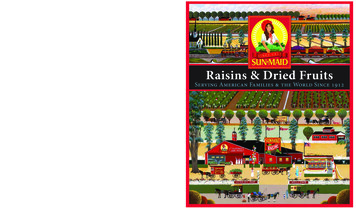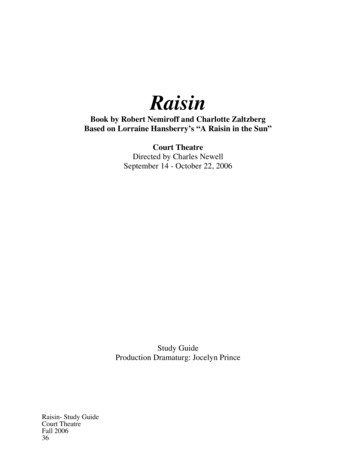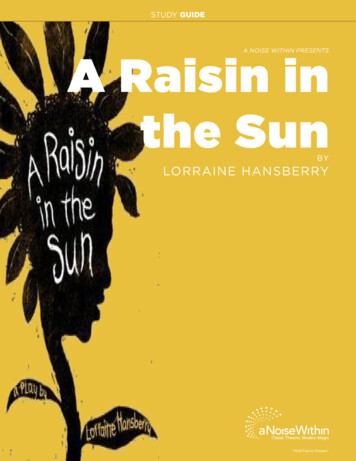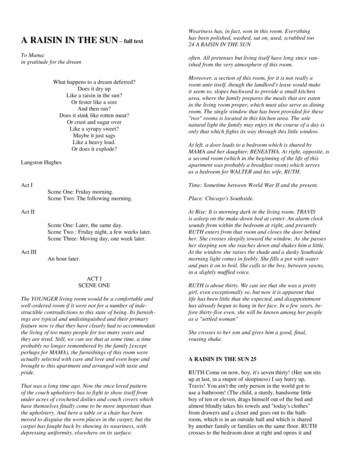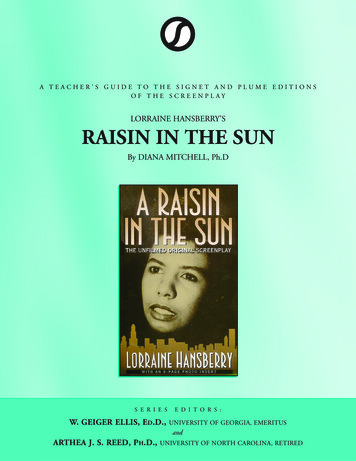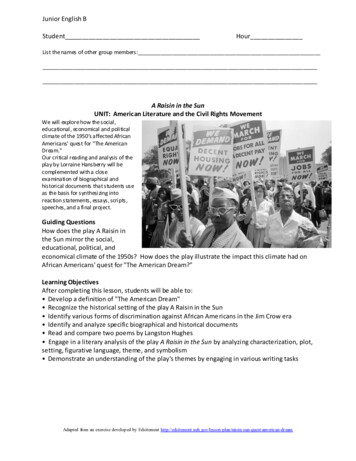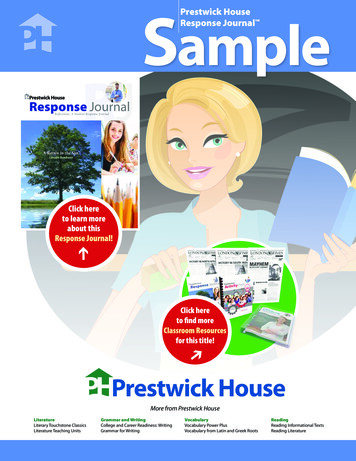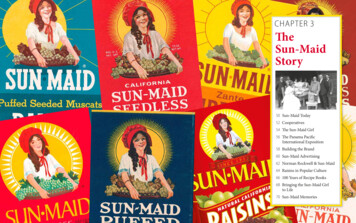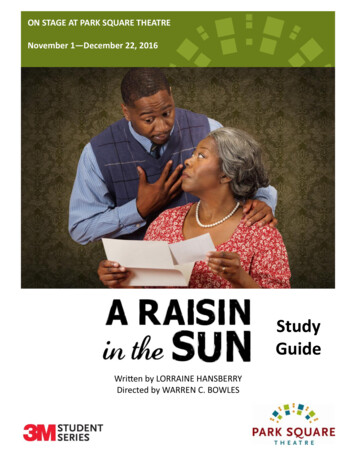
Transcription
ON STAGE AT PARK SQUARE THEATRENovember 1—December 22, 2016StudyGuideWritten by LORRAINE HANSBERRYDirected by WARREN C. BOWLES
CotributorsPark Square TheatreStudy Guide StaffEDITORTanya Sponholz*COPY EDITORMarcia Aubineau*CONTRIBUTORSTanya Sponholz*, Theodore Fabel*,Jennifer Parker*, Craig Zimanske*COVER DESIGN AND LAYOUTMegan Losure (Education Sales andServices Manager), Alexandra Hatch(Education Assistant)*Past or Present Member of thePark Square Theatre Teacher Advisory BoardContact UsPARK SQUARE THEATRE408 Saint Peter Street, Suite 110Saint Paul, MN 55102EDUCATION: ksquaretheatre.orgIf you have any questions or comments aboutthis guide or Park Square Theatre’s EducationProgram, please contactContributorsPark Square TheatreTeacher Advisory BoardMarcia AubineauUniversity of St. Thomas, retiredLiz EricksonRosemount High School, retiredTheodore FabelSouth High SchoolCraig FarmerPerpich Center for Arts EducationAmy Hewett-OlatundeLEAP High School, EdDCheryl HornsteinFreelance Theatre and Music EducatorAlexandra HowesTwin Cities AcademyDr. Virginia McFerranPerpich Center for Arts EducationKristin NelsonBrooklyn Center High SchoolMari O’MearaEden Prairie High SchoolJennifer ParkerFalcon Ridge Middle SchoolMaggie QuamHmong College Prep AcademyKate SchillingMound Westonka High SchoolJack SchlukebierCentral High School, retiredTanya SponholzPrescott High SchoolJill TammenHudson High School, retiredCraig ZimanskeForest Lake Area High SchoolMary Finnerty, Director of EducationPHONE 651.767.8494EMAIL e.org page 2
Study GuideContentsThe Play and the Playwright4. Plot Summary5. Meet the Characters6. A Conversation with the Actors9. Lorraine Hansberry: Playwright, Author, and ActivistHistorical Context11. Historical Context of A Raisin in the Sun14. What Could You Buy with 10,000?16. Map Analysis: Segregation and Poverty in the Twin CitiesActivities and Resources21. Tossing Lines: A Pre-Play Class Activity23. Text Analysis: Scene to Read Aloud #126. Text Analysis: Scene to Read Aloud #229. The Origin of the Title30. Evoking Empathy: Examining Walter Lee’s Complexity32. Afrocentrism and Beneatha33. White Privilege: A Post-Play Activity35. Post-Play Discussion Questionswww.parksquaretheatre.org page 3
THE PLAY AND THE PLAYWRIGHTPlot SummaryA Raisin in the SunThe Youngers are a poor African American familyliving in a rundown but well cared for apartment onthe segregated South Side of Chicago in the 1950s.The possibility of economic independence is given tothe family when Mama (Lena Younger) receives a 10,000 life insurance check upon the death of herhusband. Each member of the family dreams of thepossibilities the money could provide. Mama dreamsof moving her family to a new home in an affluentChicago neighborhood. Her son, Walter Lee, achauffeur, dreams of buying a liquor store, providinghim the financial resources to take care of his familyincluding his pregnant wife, Ruth, and young son,Travis. His sister, Beneatha, dreams of paying for andfinishing medical school.Tensions and sibling rivalry within the family build aseach member contemplates how to use the money tofurther their own dreams. Walter Lee feels he is entitled to the money as the head of the family. Ruth andBeneatha disagree and feel that the money belongsto Lena, and she alone should decide how to spend it.Mama deeply feels that the family’s survival dependson their escape from the apartment and the neighborhood. She decides to make a down payment on ahouse in Clybourne Park, an all-white Chicago neighborhood. Her decision to make the down payment isdone without consulting any of her family members.The family’s reactions range from disbelief and disappointment to happiness and delight.through when one of the "investors" runs awaywith all the money.The family is deeply dependent on the money andis devastated to learn of Walter Lee’s reckless investment. Seeing no way out from his poor choice,Walter Lee seriously considers taking an offer fromMr. Lindner, a representative from the ClybournePark neighborhood. Mr. Lindner’s offer would paythe Youngers a substantial amount of money not tomove into the neighborhood. The option of a payoff is immoral in the family's eyes. Walter Lee isdetermined to make the deal despite his misgivings, but at the last moment while in the presenceof his son, he does not take the bribe. In the end,the family decides to move to Clybourne Park eventhough the road ahead will be difficult; they hopethat they have made the right choice for the familyand the generations to follow.After making the down payment on the house, Mamarealizes the significance of Walter Lee’s plan to buy aliquor store. Walter Lee dreams of giving his family allthat is imaginable even in the face of racism and discrimination. Mama gives Walter Lee the rest of theinsurance money with the stipulation that a considerable portion be put away for his sister's medicalschool education. Walter Lee, being the man of thefamily, decides to invest all of the remaining money inthe liquor store business with two men. The plan fallsBy Jennifer Parker, Falcon Ridge Middle Schoolwww.parksquaretheatre.org page 4
THE PLAY AND THE PLAYWRIGHTMeet the CharactersA Raisin in the SunLena Younger: Known throughout the play as“Mama,” Lena, who recently lost her husband,Walter Sr., is the matriarch of the Younger family.Mama’s actions show her strength, spirituality,and selflessness.Travis Younger: As the youngest member of theYounger family living in a three-generation household, Travis is playful and clever, knowing how toplay the adults in the family to get what he wants.He’s the ten-year-old son of Walter Lee and Ruth.Walter Lee Younger: As Lena’s oldest child,Walter Lee feels the pressure to be the providerfor his mother as well as his wife Ruth and sonTravis. A man in his mid-thirties, Walter Lee worksas a chauffeur for a wealthy white family, but hehas aspirations for bigger and better things.Joseph Asagai: An immigrant from Nigeria, JosephAsagai is one of Beneatha’s suitors. He opens hereyes to Nigerian customs.Beneatha Younger: Also known as “Bennie,”Beneatha is Lena’s second child and Walter Lee’ssister. She is in college and is eagerly lookingforward to attending medical school. Shecurrently has two suitors: George Murchison andJoseph Asagai.Ruth Younger: Even though Ruth married into theYounger family, she is the peace-maker, helpingto extinguish conflict between her husband,Walter Lee, and sister-in-law, Beneatha. She helpsher mother-in-law care for their home.George Murchison: In contrast to the Younger’spoverty, George Murchison is a very wealthy collegestudent. He is the other of Beneatha’s suitors.Karl Lindner: As a member of the Clybourne ParkWelcoming Committee, Karl Lindner meets with theYounger family to discuss the neighborhood’spolicies.Bobo: One of Walter Lee’s business partners.Bobo, too, hopes for bigger and better things.The Younger Family as depicted inthe 1961 film, A Raisin in the Sun.By Tanya Sponholz, River Falls High School &Craig Zimanske, Forest Lake Area High Schoolwww.parksquaretheatre.org page 5
THE PLAY AND THE PLAYWRIGHTA Conversation with the ActorsA Raisin in the SunThe following questions were asked of some of the cast of Park Square Theatre’s 2016 production ofA Raisin in the Sun:Greta Oglesby (Lena Younger)When did you become an actor, and what were some of your first roles?I served as an accountant for the city of Chicago for 15 years and fell intoacting in 1992. Some of my first roles were in God's Trombones and DoLord Remember Me.As an actor, what inspires you?I am inspired by the everyday: relationships of all types, happy ones,complicated ones, also by literature, music, dance, poetry, the bus,subway, or a city street.Greta OglesbyWhat is your relationship with the character that you will be playing in A Raisin in the Sun? What do youfeel is important, beautiful, frustrating, etc. about her?I first understudied Phylicia Rashad in the role of Lena on Broadway in 2004. I have loved this play and thisrole for many years. I love Lena's faith, strength, and dignity. What frustrates me is, as her name suggests,Lena's family "leans" on her and draws from her strength in order to replenish their own.What advice do you have for young people who want to become theater artists?Believe in your goals, study, study, study, and make sure you LOVE what you do.Darius Dotch (Walter Lee Younger)When did you become an actor, and what were some of your first roles?I've been doing theater ever since high school and throughout college, but Iwould say that I first officially felt like an actor after I graduated college withmy theater degree and got my very first gig. Some of my first (memorableroles) were in Broke-ology and A Civil War Christmas.As an actor, what inspires you?I'm inspired by the challenges with each new role. Acting is a veryvulnerable craft. To truly dive into a character and put your feelings outDarius DotchCONTINUED.www.parksquaretheatre.org page 6
THE PLAY AND THE PLAYWRIGHTfor the audience to see can be a daunting task. It all pays off when it's time to take a bow.What is your relationship with the character that you will be playing in A Raisin in the Sun? What doyou feel is important, beautiful, frustrating, etc. about him?I love Walter's drive and motivation to be successful. He is a dreamer and truly wants the best for hisfamily. What frustrates me about him is that he struggles to actually hear his family’s wants and needs.When he finally does, it's almost too late.What advice do you have for young people who want to become theater artists?Do it from the heart. Don't do it because you want to be famous or rich. Do it because you love it. Bepassionate. Be honest with it. Most importantly, be a “work-aholic.” Constantly work on your craft.Theo Langason (George Murchison or Joseph Asagai)When did you become an actor, and what were some of your first roles?I did my first play when I was 12 or 13. It was a play about Brown v. theBoard of Education. I don't remember what role I played. Maybe a lawyer?Someone's dad? That's probably a safe bet. I played someone's dada lot early in my career.As an actor, what inspires you?I am inspired by passion in all fields. If I see a person who is passionateabout what they are doing, it really gets my juices flowing. I'm a directorand musician as well and other arts are a constant source of inspiration.Especially live music.Theo LangasonWhat is your relationship with the character that you will be playing in A Raisin in the Sun? What doyou feel is important, beautiful, frustrating, etc. about him?My role is still in flux, Warren Bowles (our Director) is deciding if he wants me to play George Murchisonor Joseph Asagai. This is a really fascinating pair to be considered for because they are two sides of thesame coin. Both are educated, young black men seeking Beneatha's heart. George is fully assimilatedinto white American culture and has a deep loathing for his own blackness that he takes out on otherblack people. He's the kind of black person that white culture finds most palatable: well-spoken, wellmannered, and content with the status quo. Asagai on the other hand is a Nigerian expatriate, so veryconnected to the roots of his blackness. Asagai is particularly interesting to me because my father isfrom Cameroon which borders Nigeria. My father was not too different from Asagai when he came hereover 30 years ago for school. So we'll see what Warren decides! Either way, I'm very excited to be inthis production.What advice do you have for young people who want to become theater artists?The same advice I would give to anyone: failure is your friend. For every success you have, there will bedozens of failures, so the more you fail, the more you will succeed.CONTINUED.www.parksquaretheatre.org page 7
THE PLAY AND THE PLAYWRIGHTNeal Hazard (Bobo)When did you become an actor, and what were some of your first roles?I started to really dive into acting in ‘92 after graduating from the Universityof Rhode Island. Some of my first roles were in Langston Hughes' Jesse B.Simple, The Zoo Story, Stop Kiss, and Othello.As an actor, what inspires you?I'm inspired by watching amazing performances, especially when they'redone by friends of mine. I also maintain inspiration by sharing greatmoments with someone on stage/film, and when those moments are foundunintentionally, it's what they call “magic.”What is your relationship with the character that you will be playing inA Raisin in the Sun? What do you feel is important, beautiful, frustrating,etc. about him?Neal HazardIn the short amount of time that we get to know Bobo, we know that he's a loyal friend to Walter Lee. Hecould also stand to use some of Walter Lee's drive for a better life.What advice do you have for young people who want to become theater artists?Be prepared! Understand there is business in show business, and have a skill/talent/trade that you caneasily fall back on during those "slow" times. Be great!Robert Gardner (Karl Lindner)When did you become an actor, and what were some of your first roles?I became an actor when I was in junior high. My mother forced me totry out for the play (I don’t remember the title), and I was cast. Until themoment I stepped on stage before an audience, I was terrified. After that,well, it was fun!As an actor, what inspires you?I’m inspired by playwrights who mix moods—funny/sad—and by actorswho create and reveal the rich humanity—good and bad—of a character.Many years ago I did a close study of the language of an Irish play, Juno andthe Paycock. Lines from the Abbey Theatre recording of that play have beenechoing in my head and my heart ever since.Robert GardnerCONTINUED.www.parksquaretheatre.org page 8
THE PLAY AND THE PLAYWRIGHTWhat is your relationship with the character that you will be playing in A Raisin in the Sun? What do youfeel is important, beautiful, frustrating, etc. about him?I play Lindner, the only white character in the play, and he’s not exactly a positive role model. He’s obviouslya racist and he is representing an obviously racist white community association. I like to think I’m not likehim. Although born in Biloxi, Mississippi, and raised in an all-white suburb of Washington, D.C., I’m a “good”white liberal who went to Oberlin College, the first college in the country to admit black people (and women). But Oberlin, the epitome of progressive social values, was strongly challenged this year by its black students for racism, a fact that makes me look more closely at myself and to worry that perhaps I’m not sodifferent from Lindner. The challenge of the role will be to find how I can connect with this man—and present him in a way that audiences will connect with him, positively and negatively.What advice do you have for young people who want to become theater artists?Seek out good teachers. Seize the opportunities that present themselves. Stay positive as you experience theups and downs of a life in theater.By Theodore Fabel, South High Schoolwww.parksquaretheatre.org page 9
THE PLAY AND THE PLAYWRIGHTLorraine Hansberry:Playwright, Author, and Activist“Quite simply and quietly as I know how to say it: I am sick of poverty, lynching, stupid wars, and the universal mal-treatment of my people and obsessed with a rather desperate desire for a new world for meand my brothers.”--Lorraine HansberryEarly LifeLorraine Hansberry was born at Provident Hospital on the South Side of Chicago on May 19, 1930. She wasthe youngest of Nannie Perry Hansberry and Carl Augustus Hansberry’s four children. Her father foundedLake Street Bank, one of the first banks for blacks in Chicago, and ran a successful real estate business. Heruncle was William Leo Hansberry, a scholar of African studies at Howard University in Washington, D.C.Many prominent African American social and political leaders visited the Hansberry household during Lorraine’s childhood including sociology professor W.E.B. DuBois, poet Langston Hughes, actor and politicalactivist Paul Robeson, musician Duke Ellington and Olympic gold medalist Jesse Owens.Despite their middle-class status, the Hansberrys were subject to segregation. When she was eight yearsold, Hansberry’s family deliberately attempted to move into a restricted neighborhood. Restrictive covenants, in which white property owners agreed not to sell to blacks, created a ghetto known as the “BlackBelt” on Chicago’s South Side. Carl Hansberry, with the help of Harry H. Pace, president of the Supreme Liberty Life Insurance Company, and several white realtors secretly bought property at 413 E. 60th Street and6140 S. Rhodes Avenue. The Hansberrys moved into the house on Rhodes Avenue in May 1937. The familywas threatened by a white mob which threw a brick through a window, narrowly missing Lorraine. The Supreme Court of Illinois upheld the legality of the restrictive covenant and forced the family to leave thehouse. The U.S. Supreme Court reversed the decision on a legal technicality. The result was the opening of30 blocks of South Side Chicago to African-Americans. Although the case did not argue that racially restrictive covenants were unlawful, it marked the beginning of their end.Lorraine graduated from Englewood High School in Chicago, where she first became interested in theater.She enrolled in the University of Wisconsin but left before completing her degree. After studying painting inChicago and Mexico, Hansberry moved to New York in 1950 to begin her career as a writer. She wrote forPaul Robeson’s Freedom, a progressive publication, which put her in contact with other literary and politicalmentors such as W.E.B. DuBois and Freedom editor Louis Burnham. During a protest against racial discrimination at New York University, she met Robert Nemiroff, a Jewish writer who shared her political views.They married on June 20, 1953 at the Hansberrys’ home in Chicago.Commercial SuccessIn 1956, her husband and Burt D’Lugoff wrote the hit song, “Cindy, Oh Cindy.” Its profits allowed Hansberryto quit working and devote herself to writing. She then began a play she called The Crystal Stair, from Langston Hughes’ poem “Mother to Son.” She later retitled it A Raisin in the Sun from Hughes’ poem, “Harlem:A Dream Deferred.”In A Raisin in the Sun, the first play written by an African-American to be produced on Broadway, she drewCONTINUED.www.parksquaretheatre.org page 10
THE PLAY AND THE PLAYWRIGHTupon the lives of the working-class black people who rented from her father and who went to school withher on Chicago’s South Side. She also used members of her family as inspiration for her characters.Hansberry noted similarities between Nannie Hansberry and Mama Younger and between Carl Hansberryand Big Walter. Walter Lee, Jr. and Ruth are composites of Hansberry’s brothers, their wives and her sister, Mamie. In an interview, Hansberry laughingly said, “Beneatha is me, eight years ago.”Her second play, The Sign in Sidney Brustein’s Window, about a Jewish intellectual, ran on Broadway for101 performances. It received mixed reviews. Her friends rallied to keep the play running. It closed onJanuary 12, 1965, the day Hansberry died of cancer at age 35.LegacyAlthough Hansberry and Nemiroff divorced before her death, he remained dedicated to her work. As literary executor, he edited and published her three unfinished plays: Les Blancs, The Drinking Gourd andWhat Use Are Flowers? He also collected Hansberry’s unpublished writings, speeches and journal entriesand presented them in the autobiographical montage To Be Young, Gifted and Black. The title is takenfrom a speech given by Hansberry in May 1964 to winners of a United Negro Fund writing competition:“ though it be a thrilling and marvelous thing to be merely young and gifted in such times, it is doubly so,doubly dynamic, to be young, gifted and black!”Article extracted in its entirety from:“Lorraine Hansberry Biography.” Chicago Public Library. Chicago Public Library & BiblioCommons, 2016.Web. 24 July 2016.Lorraine Hansberry, 1964Compiled by Tanya Sponholz, River Falls High Schoolwww.parksquaretheatre.org page 11
HISTORICAL AND CULTURAL CONTEXTThe Historical Context for A Raisin in the SunA Raisin in the Sun is set in the early 1950s in Chicago, Illinois. Listed here is the chronology of Hansberry’s lifeand work as well as historical events that took place in the United States during that time.Hansberry’s lifeYearLorraine Vivian Hansberry, the daughterof a prominent real estate broker and theniece of a Howard University professorof African history, is born in Chicagoon May 19.1930The Hansberry family lives at 5330 S.Calumet Avenue on the South Side of Chicago.1930-36US Historical ContextThe Hansberry family moves to 6140 Rhodes1937Avenue, in an all-white neighborhood near theUniversity of Chicago. Hostile residents attacktheir home. A state judge rules that the Hansberryshave to move. They appeal to the Supreme Court.The Hansberrys and the NAACP win the U.S.Supreme Court Case Hansberry v. Lee.Hansberry enters Englewood High Schooland wins a writing award for a short storyabout football.1940Richard Wright publishes Native Sun.1941The United States enters World War II.1944Hansberry’s father dies of a cerebral hemorrhage 1946in Mexico, where he had planned to relocatehis family to escape U.S. racism.1947Jackie Robinson joins the Brooklyn Dodgers and becomes the first African Americanto play major league baseball.CONTINUED.www.parksquaretheatre.org page 12
HISTORICAL AND CULTURAL CONTEXTHansberry’s lifeYearHansberry graduates from Englewood High School 1948and enters the University of Wisconsin in Madison.1950Hansberry becomes the youngest staff memberof Freedom newspaper, founded by PaulRobeson and Louis E. Burnham.US Historical ContextPresident Truman ends racialsegregation in the U.S. armed forces.Gwendolyn Brooks is awarded thePulitzer Prize for Annie Allen.1951Hansberry attends the International Peace1952Congress in Montevideo, Uruguay, on behalf ofPaul Robeson who was forbidden to leave the U.S.by the State Department.Hansberry takes courses in African history fromDr. W.E.B. DuBois at the Jefferson School ofSocial Science in New York.Hansberry finishes A Raisin in the Sun.1954The U.S. Supreme Court finds segregatedschools unconstitutional in Brown v. Boardof Education.1955Rosa Parks is arrested in Montgomery, Alabama, for refusing to give up her seat on abus to a white passenger, sparking a busboycott.1957A Raisin in the Sun, directed by Lloyd Richards1959and starring Sidney Poitier, opens on Broadway,wins the New York Drama Critics Circle Award andruns for 530 performances.Hansberry writes two screenplays ofA Raisin in the Sun, both of which are rejectedby Columbia Pictures; her third, the leastcontroversial version, is accepted.1960Students hold “sit-ins” in Greensboro,N.C.CONTINUED.www.parksquaretheatre.org page 13
HISTORICAL AND CULTURAL CONTEXTHansberry’s lifeYearThe movie version of A Raisin in the Sunpremieres in Chicago. The film winsa special Cannes Film Festival Award.1961Hansberry becomes involved in thecivil rights movement and the StudentNonviolent Coordinating Committee(SNCC) and confronts Attorney GeneralRobert Kennedy on the administration’sefforts against racism. She is diagnosedwith cancer.1963Hansberry dies on January 12, the sameday that her second Broadway play,The Sign in Sidney Brustein’s Window, closes.1965The two-year anniversary of Hansberry’s1967death is commemorated with a seven-hourradio documentary called Lorraine Hansberryin Her Own Words featuring recorded performancesby 61 of America’s greatest actors.1968To Be Young, Gifted and Black opensoff-Broadway, runs for 380 performances,and is published as a book.1969Raisin, a musical adaptation of A Raisin inthe Sun, opens on Broadway, wins theTony Award as best musical, and runsfor 874 performances.1973A Raisin in the Sun, starring Danny Gloverand Esther Rolle, is directed by Bill Dukefor American Playhouse/PBS television.1989A Raisin in the Sun comes back to Broadway,winning two Tony Awards for actressesPhylicia Rashad and Audra McDonald.2004A Raisin in the Sun wins three Tony awards,including Best Revival of a play.2014Source:“Historical Context of A Raisin in the Sun.” ChicagoPublic Library. Chicago Public Library & BiblioCommons, 2016. Web. 05 July 2016.US Historical ContextMedgar Evers is killed inJackson, Mississippi.Martin Luther King, Jr.gives his “I Have a Dream”speech.President John F. Kennedy isassassinated in Dallas.Martin Luther King, Jr. is assassinated.Compiled by Theodore Fabel, South High Schoolwww.parksquaretheatre.org page 14
HISTORICAL AND CULTURAL CONTEXTWhat Would You Do with 10,000?A Classroom ActivityWhen the Youngers receive the 10,000 check, each family member has a different plan for how the moneywould best be spent. Conflicts arise, since even in 1950, 10,000 would only go so far. Your task is tocompare prices of basic items in 1950 and 2016 and ultimately discover how much 10,000 would be intoday’s money.First, look up the typical price of basic items in 1950 and 2016. Choose two of your own, too!19502016Average Household IncomeGallon of MilkLoaf of BreadGallon of GasolinePostage StampSunday NewspaperMedian Home Value in MNFord Fordor Sedan (1950)/Ford Fusion Sedan (2016)1 Year at UW-Madison(Tuition Only)Next, using the CPI Inflation Calculator website, determine how much 10,000 in 1950 would be worth in today’s dollars. http://data.bls.gov/cgi-bin/cpicalc.pl 10,000 (in 1950) (in 2016)CONTINUED.www.parksquaretheatre.org page 15
HISTORICAL AND CULTURAL CONTEXTFinally, consider the following questions:1. Inflation means that the prices of goods will generally increase over time, which in turn causes thepurchasing power of money to fall. You found out that 10,000 in 1950 would be today. Basedon the prices you charted above, in which time would that money go farther?2. The minimum wage in 1950 was 0.75/hour. In 2016, in Minnesota, the minimum wage is 9.50. Using theprices you charted on the previous page, how many hours would a person earning the minimum wage in1950 have to work to buy the following items?1 Gallon of Milk1 Loaf of Bread15 Gallons of Gasoline20 Postage StampsHow many hours would a person earning minimum wage in 2016 have to work to buy those same items?From this data, has the minimum wage kept up with inflation?3. Using the same numbers for minimum wage in question 2, how many hours would a person earningminimum wage have to work to completely self-fund a year of college in 1950? In 2016? From this data, hasthe minimum wage kept up with college tuition inflation? What steps could be taken by the federal or stategovernments to alleviate this burden?4. Based on the research you conducted above, do you think a person working full-time and earningminimum wage could afford to live comfortably in 1950? In 2016? Explain your reasoning.Picture from The Chicago Reader, 2013.By Craig Zimanske, Forest Lake Area High Schoolwww.parksquaretheatre.org page 16
HISTORICAL AND CULTURAL CONTEXTMap Analysis: Segregation and Poverty in theTwin CitiesOne of the major conflicts in A Raisin in the Sun is the debate between the family members about whetherthey should move into an all-white neighborhood. While this play takes place in the 1950s, racial segregation in housing still exists right here in the Twin Cities. Use the maps from the University of Minnesota toexplore issues of poverty and race in the Twin Cities over the last 30 years.Discussion Questions:1. Compare maps 1 and 3. What are some differences that you see between the two maps?Do the same comparison for maps 2 and 4.2. The federal census is taken every ten years. In the 1980 census what areas of the Twin Cities saw thelargest minority populations? What areas were mostly white? How did that change by 2010?3. Based on the maps, is there a relationship between poverty and racially segregated neighborhoods?4. Has the number of people living in poverty in the Twin Cities increased or decreased in the last30 years?5. What factors could have led to a change in the poverty rate over the last 30 years?6. Thinking about the Younger family in the play, identify a neighborhood the Youngers might havelived in at the start of the play. Identify a neighborhood they may have moved to.7. Find your neighborhood. How it has changed over the years?8. Which is healthier for our society: to live in a segregated neighborhood or an integratedneighborhood? Why?The Hansberry Home in Washington Park, Chicago, ILCONTINUED.www.parksquaretheatre.org page 17
HISTORICAL AND CULTURAL CONTEXTMap 1: Percentage Below Poverty Line, 1979CONTINUED.www.parksquaretheatre.org page 18
HISTORICAL AND CULTURAL CONTEXTMap 3: Percentage Below Poverty Line, 2008-2012CONTINUED.www.parksquaretheatre.org page 19
HISTORICAL AND CULTURAL CONTEXTMap 2: Percentage Minority Population, 1980CONTINUED.www.parksquaretheatre.org page 20
HISTORICAL AND CULTURAL CONTEXTMap 4: Percentage Minority Population, 2008-2012By Jennifer Parker, Falcon Ridge Middle Schoolwww.parksquaretheatre.org page 21
ACTIVITIES AND RESOURCESTossing LinesA Pre-Play Class ActivityObjective:The purpose of this activity is to familiarize students with A Raisin in the Sun by exposing them to linesspoken in the play. Based on these lines, students are to make predictions about the play’s characters andcentral conflicts and discuss these predictions. This activity helps students form questions, gain insight, andbuild excitement for seeing and hearing these lines acted out on stage. “Tossing Lines” serves the studentsbest if completed before they attend the play.Time Allotted:20-30 minutesMaterials:Tennis ball or hack
11. Historical ontext of A Raisin in the Sun 14. What ould You uy with 10,000? 16. Map Analysis: Segregation and Poverty in the Twin ities Activities and Resources 21. Tossing Lines: A Pre-Play lass Activity 23. Text Analysis: Scene to Read Aloud #1 26. Text Analysi
